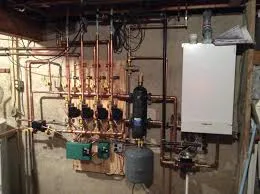
Heated floors provide utmost comfort and convenience in residential and commercial spaces. The warmth radiates evenly, creating a cozy and luxurious atmosphere. Besides the delightful aspect of warmth, heated floors also eliminate the need for bulky radiators or vents that may block living space. They offer a discreet heating solution that can be controlled individually in different zones of a building. Additionally, heated floors are energy-efficient, as they can maintain a comfortable temperature with lower heat settings compared to traditional heating systems. This not only saves energy but also reduces utility bills. Moreover, heated floors are compatible with various flooring materials, making them suitable for different interior designs and aesthetic preferences.
Furthermore, heated floors are known to provide health benefits. They eliminate the circulation of allergens and dust particles, unlike forced-air systems that can spread these pollutants. The constant warmth provided by heated floors helps to reduce moisture and prevent the growth of mold and mildew. This creates a healthier and more hygienic living environment, especially for individuals with respiratory conditions. In addition, heated floors offer a silent heating method, without the noise and irregular heating cycles associated with conventional systems. This contributes to an overall peaceful and tranquil atmosphere.
It is important to note that some considerations should be taken when installing heated floors. First, the initial investment can be higher compared to traditional heating systems, due to the cost of installation and materials. Proper installation is crucial to ensure optimal performance and prevent any damage to the flooring or the heating elements. It is recommended to consult with professionals experienced in installing heated floors for proper guidance. Additionally, the use of heated floors can limit the options for floor coverings, as some materials may not be suitable for use with this heating system.
Understanding Heated Floors
Heated floors, an innovative home heating solution, offer several advantages. Besides keeping rooms comfortably warm, these flooring systems have gained popularity due to their energy efficiency and ability to eliminate cold spots. By providing consistent heat distribution throughout the space, heated floors create a cozy and comfortable environment.
One of the primary benefits of understanding heated floors is the efficient and uniform heat distribution they offer. Traditional heating systems often result in uneven heating, leaving certain areas warmer than others. However, with heated floors, the warmth spreads evenly across the entire room, ensuring consistent comfort throughout.
Moreover, understanding heated floors encompasses the decreased reliance on other heating sources. As heated floors efficiently radiate heat upwards, they require lower operating temperatures compared to traditional forced-air systems. This not only reduces energy consumption and utility bills but also minimizes the carbon footprint, contributing to a more sustainable lifestyle.
Furthermore, heated floors also eliminate the need for bulky radiators or visible vents, giving homeowners the freedom to design their interiors without restrictions. Instead of compromising on aesthetics, understanding heated floors allows for seamless integration, with the heating system working silently and out of sight.
A true history about the concept of heated floors dates back to ancient Roman times, where they were known as “hypocausts.” The Romans realized the benefits of underfloor heating systems and used them extensively in their bathhouses, villas, and public spaces. The concept was further developed and used throughout history, with modern technology now making heated floors accessible to residential and commercial spaces worldwide.
The Disadvantages of Heated Floors
Heated Floors: Demerits Unveiled
Discover the drawbacks of heated floors, providing you with a comprehensive understanding of their limitations.
The Disadvantages of Heated Floors:
- Installation Costs: The initial expenses related to installing heated floors can be quite high, including the cost of materials, labor, and any necessary modifications to the existing flooring.
- Complex Installation: Installing heated floors can be a complex process, requiring skilled professionals to ensure proper installation and prevent any potential damage to the flooring or heating system.
- Higher Electricity Consumption: Heated floors require a continuous source of electricity to function, which can lead to increased energy consumption and subsequently higher utility bills.
- Slow Heating: Unlike traditional heating systems, heated floors take longer to reach the desired temperature. This delay can be inconvenient, especially in situations where quick heating is required.
- Difficulty in Repairs: Any technical issues or damages to the heating system or flooring can be challenging to repair. The intricate nature of the system may require specialized knowledge and professional assistance.
- Flooring Options: Heated floors are not compatible with all types of flooring materials. Certain floor coverings, such as thick carpets or hardwood, may not conduct heat effectively, limiting the flooring options for heated floors.
Moreover, it is important to note that heated floors cannot provide cooling functions, and they may not be suitable for certain climates or rooms that require both heating and cooling capabilities.
As a testament to the limitations of heated floors, consider the experience of Jane, a homeowner who installed heated floors in her bathroom. Despite enjoying warm floors during winter, she faced challenges with repairs when a water leak occurred. The expertise of a specialized technician was required to fix the issue, which resulted in unexpected expenses and inconvenience.
By understanding the disadvantages of heated floors, individuals can make well-informed decisions when considering this heating option for their homes.
Electric vs. Hydronic Radiant Floor Heating
Electric vs. Hydronic Radiant Floor Heating is a comparison between two types of heating systems for floors. Let us explore the key differences between these two methods.
In addition to the above details, electric radiant floor heating is often preferred for its affordability and ease of installation. It is an excellent choice for smaller spaces or specific rooms you want to heat efficiently. On the other hand, hydronic radiant floor heating is better suited for larger areas or whole-house heating, providing a more consistent and comfortable warmth.
As you can see, the choice between electric and hydronic radiant floor heating depends on your specific needs and preferences. Consider the size of the area you want to heat, your budget, and the level of maintenance you are willing to undertake.
If you want a hassle-free, affordable heating solution for a small space, electric radiant floor heating is the way to go. However, if you desire a consistent warmth throughout your entire house, hydronic radiant floor heating is the ideal choice. Don’t miss out on the benefits of these efficient heating systems – make the right decision based on your needs.
Conclusion: Considering the Drawbacks of Heated Floors
Heated floors have certain drawbacks that should be taken into consideration. Despite their advantages, there are a few factors to keep in mind. For instance, the installation process of heated floors can be costly and time-consuming. Additionally, heated floors may also limit the ability to make changes to the flooring in the future. Moreover, the maintenance and repair of heated floors can be complex and expensive. It is important to weigh these drawbacks against the benefits before making a decision.
Some Facts About the Disadvantages of Heated Floors:
- ✅ Heated floors can be expensive to install, especially in larger areas or whole-house applications.
- ✅ Electric radiant floor heating systems may result in higher energy costs compared to other heating systems.
- ✅ Hydronic radiant floor heating systems require a boiler and associated equipment, resulting in higher upfront costs.
- ✅ Radiant floor heating systems can be difficult to retrofit into existing homes without significant renovation.
- ✅ Repairs to the heating element or pipes in radiant floor heating systems can be costly and invasive.
FAQs about What Are The Disadvantages Of Heated Floors?
What are the disadvantages of heated floors?
While heated floors offer numerous advantages, there are a few disadvantages to consider:
1. Are heated floors expensive to install?
The cost of installing heated floors can vary depending on factors such as the size of the area, the type of system (electric or hydronic), and whether it’s a new installation or a retrofit. Generally, electric systems are more affordable upfront compared to hydronic systems, which require a boiler and associated equipment. However, both types can be costly to install.
2. Is maintenance required for heated floors?
Electric radiant floor heating systems typically require very little maintenance once installed properly. On the other hand, hydronic systems may require occasional maintenance, such as checking the boiler, ensuring proper water circulation, and addressing any leaks or issues that may arise. It’s important to consult the manufacturer’s guidelines for maintenance requirements.
3. Can heated floors be the sole heat source for a home?
While heated floors can provide comfortable and efficient warmth, they may not be sufficient as the sole heat source for an entire home. Factors such as insulation, climate, and the size of the space should be taken into account. It’s recommended to use a heat loss calculator or consult with a heating professional to determine if heated floors can serve as the primary heat source or if supplementary heating is necessary.
4. Do heated floors impact energy consumption?
Heated floors can be energy-efficient when used properly, as they allow for more even heat distribution and can help reduce the need for traditional heating methods. However, the energy consumption will depend on factors such as the type of system, the temperature settings, and the insulation of the space. It’s important to use a programmable thermostat and set temperature levels appropriately to optimize energy efficiency.
5. Are there any limitations to heated floors?
Heated floors may have limitations in terms of their installation. For example, certain flooring materials may not be suitable for use with electric radiant floor heating systems, and the choice may be limited. Additionally, retrofitting existing flooring to accommodate heated floors may require additional time and cost. It’s important to consider these limitations when planning a heated floor installation.
6. Can heated floors result in discomfort?
While radiant floor heating provides a comfortable and even warmth, personal preferences may vary. Some individuals may find the floor temperature too warm, especially in higher settings. It’s important to consider individual comfort levels and adjust the thermostat settings accordingly. Additionally, the sensation of radiant heat can be different from traditional heating methods, and it may take some time to adjust and find the optimal temperature for each room.

